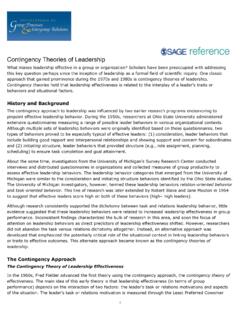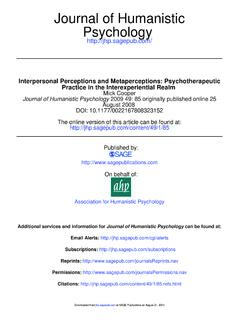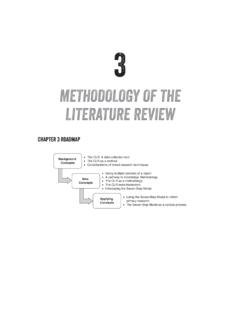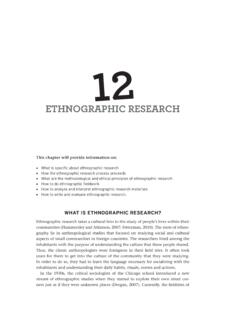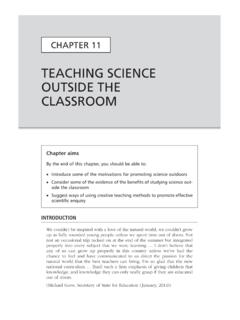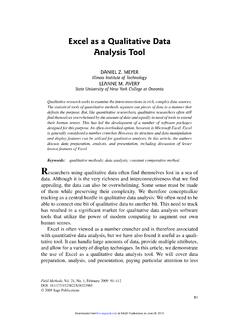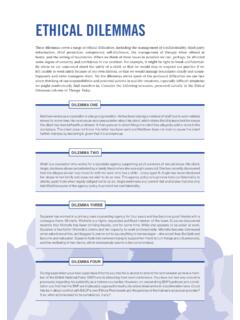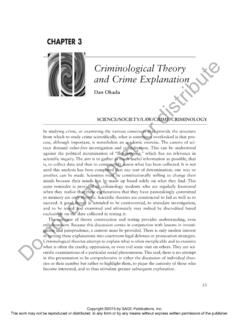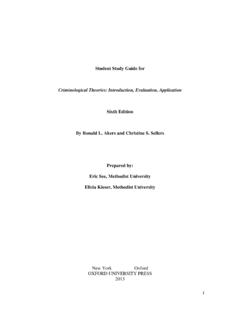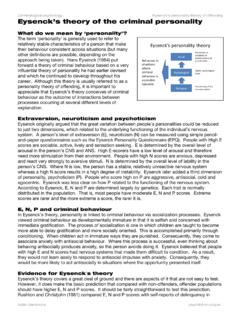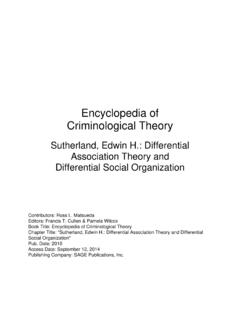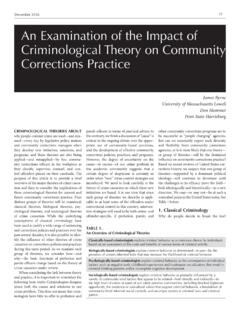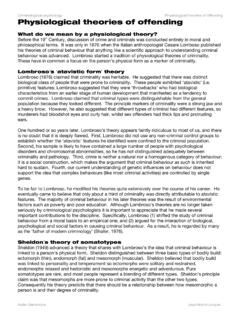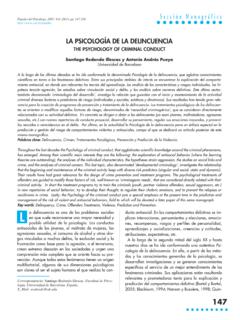Transcription of Encyclopedia of Criminological Theory
1 Encyclopedia ofCriminological TheoryMerton, Robert K.: SocialStructure and AnomieContributors: Steven F. MessnerEditors: Francis T. Cullen & Pamela WilcoxBook Title: Encyclopedia of Criminological TheoryChapter Title: "Merton, Robert K.: Social Structure and Anomie"Pub. Date: 2010 Access Date: September 12, 2014 Publishing Company: SAGE Publications, : Thousand OaksPrint ISBN: 9781412959186 Online ISBN: 9781412959193 DOI: pages: 613-620 2010 SAGE Publications, Inc. All Rights PDF has been generated from SAGE knowledge. Please note that the paginationof the online version will vary from the pagination of the print 2010 SAGE Publications, Inc. All Rights knowledgePage 3 of 17 Encyclopedia of Criminological Theory : Merton,Robert K.: Social Structure and K. Merton was one of the most distinguished and influential sociologists of the20th century. Throughout his career, he was a leading figure in the sociology of science,and he made substantial contributions to general sociological Theory by developingthe paradigm of structural analysis.
2 In the field of criminology, Merton is best knownfor advancing and popularizing the anomie perspective on crime . This perspectivehighlights the ways in which the normal features of the social organization of Americansociety ironically contribute to high levels of crime and other forms of deviant behaviorby producing anomie, a breakdown in the culture. This anomie or cultural breakdown ischaracterized by a very strong emphasis on the importance of success goals (especiallymonetary success) and a comparatively weak emphasis on the importance of using thenormatively approved means to achieve these goals. Merton further argues that sucha strain toward anomie arises when the culture encourages virtually everyone to aspireto lofty goals, while those located at the lower ends of the class hierarchy have limitedaccess to the legitimate means for success. People in such circumstances experiencepressures to innovate that is, to substitute technically expedient but often illegalmeans in the pursuit of their introduced his initial formulation of the anomie perspective in a brief articletitled Social Structure and Anomie, which was published in the American SociologicalReview in 1938.
3 He was a little-known instructor at Harvard University at the time,and his article did not create much of a stir at first. This would change the course of subsequent decades, Merton's arguments as introduced in theinitial article and as subsequently elaborated, most significantly in his book SocialTheory and Social Structure, have inspired an extraordinary volume of empiricalstudies on crime and deviance, as well as numerous theoretical extensions, exegeses,and critiques. Recently Robert Agnew has attempted to build on Merton's work byexplicating more fully the ways in which social psychological experiences of strain link adverse social conditions with crime and delinquency, while Steven Messnerand Richard Rosenfeld have highlighted the role of imbalances among major socialinstitutions (economy, family, the polity) in generating anomie. In addition, Merton'sideas about the sociological causes of crime and delinquency have had a profoundinfluence well beyond the academic community.
4 His ideas have informed majorpolicy initiatives that seek to prevent crime by enhancing job opportunities and bySAGE 2010 SAGE Publications, Inc. All Rights knowledgePage 4 of 17 Encyclopedia of Criminological Theory : Merton,Robert K.: Social Structure and Anomieproviding social services, such as those associated with the Great Society in the , much contemporary discourse about the role inequality of opportunity as acause of crime continues to be rooted in insights that are traceable to Social Structureand Anomie. Social Structure and Anomie andSociological TheoryMerton's paradigm of social structure and anomie commonly referred to by Merton andscholars generally by its acronym, SS&A has a deceptive simplicity surrounding it. Asthe information scientist Eugene Garfield has observed, much of Merton's work seems so transparently true that one can't imagine why no one else has bothered to point itout (quoted in Kaufman, 2003).
5 This quality of Merton's scholarship is attributable inlarge measure to his mastery of the English language. Merton had the ability to writeclear, engaging prose, free of opaque, confusing, and pompous jargon (Holton,2004, p. 515). As a result, core elements of his theorizing are easily discerned by thegeneral reader, and they can be summarized quite succinctly, as presented , SS&A can be read at multiple levels. At one level, Merton offers a concise,incisive description of American culture and suggests a few rather straightforwardpropositions about the relationship between social class position and crime . At a deeperlevel, SS&A represents an attempt to apply general theorizing in sociology to the specialized theorizing in criminology (Merton, 1997, p. 518). Indeed, the variousthemes developed in SS&A cohere into a highly sophisticated sociological analysis ofthe interconnections between the social organization of society and levels of crime andother forms of deviant behavior, and of the [p.]
6 613 ] ways individuals make choicesamong socially structured appreciate Merton's arguments, it is useful to locate his work in intellectualcontext. SS&A falls within the more general tradition associated with a foundingfigure in sociology mile Durkheim who introduced the concept of anomie to thesociological community, most prominently in his analyses of suicide. Durkheim assumedthat humans have no natural limits on their desires. As a result, people cannot possiblybe satisfied in the absence of some type of external restraint. Social norms provide thisSAGE 2010 SAGE Publications, Inc. All Rights knowledgePage 5 of 17 Encyclopedia of Criminological Theory : Merton,Robert K.: Social Structure and Anomieexternal restraint by circumscribing the goals that can be legitimately aspired to. Levelsof suicide are likely to increase when norms weaken and fail to fulfill this critical function,a condition which Durkheim referred to as anomie.
7 Merton appropriates Durkheim'sconcept of anomie, reinterprets its meaning somewhat, and places it prominently in thetitle of his also shares an overarching objective that motivated much of Durkheim'stheorizing. Merton intends to develop a distinctively sociological explanation for crimeand deviance to serve as an alternative to psychological, and particularly Freudian,explanations that emphasize instinctual impulses and that were popular at the time. Inso doing, Merton is essentially making the case for sociology as a scientific disciplinethat offers a unique perspective on human behavior. The questions addressed in SS&Aare thus quintessentially sociological in nature. In Merton's words,For whatever the role of biological impulses, there still remains thefurther question of why it is that the frequency of deviant behavior varieswithin different social structures and how it happens that the deviationshave different shapes and patterns in different social Ourperspective is sociological.
8 We look at variations in the rates of deviantbehavior, not at its incidence. (1968, pp. 185 186)Given the nature of the questions under examination, Merton quite naturally turnsto sociological concepts to look for the answers. He adopts the general approach insociology referred to as structural/functionalism and conceptualizes society in terms ofa social system. According to this approach, any social system can be described withreference to two fundamental properties: its culture (or culture structure) and its does not provide rigorous definitions of either culture structure or social structurein SS&A, but he clarifies their meaning while formulating his explanation for deviantbehavior. The key elements of the culture structure are the prescribed goals (orends) of action and the normatively approved (or institutionalized) means for realizingthese goals. The other component of social organization social structure refers topatterned social relationships.
9 To illustrate the application of these basic conceptualtools of sociology to the explanation of deviant behavior, Merton focuses his analyticSAGE 2010 SAGE Publications, Inc. All Rights knowledgePage 6 of 17 Encyclopedia of Criminological Theory : Merton,Robert K.: Social Structure and Anomielens on one particular social system the social system prevalent in the United Statesin the 1930s. The distinguishing feature of this social system, according to Merton,is malintegration intrinsic tensions between core features of the system. Suchmalintegration is manifested in two ways: (1) between the main components of theculture and (2) between the culture and the social structure. With respect to the culture,the priority awarded to goals and means is out of balance. The cultural emphasis onthe pursuit of goals is exceptionally strong, especially the emphasis on the goal ofmonetary success. Comparatively less emphasis is placed on the importance of usingthe institutionalized means to realize these goals.
10 Instead, societal members tendto be governed mainly by efficiency norms in the selection of means. People areprone to use whatever means are technically expedient in striving to reach their goals,regardless of whether these means are socially approved of or not. These twin featuresof culture the strong emphasis on monetary success goals and the weak emphasison normative means are part of the dominant cultural ethos of the society; they are atthe heart of the American Dream. Moreover, for Merton (1964, p. 226), the breakdownin the culture associated with the American Dream constitutes the essence of anomieor normlessness: when a high degree of anomie has set in, the rules once governingconduct have lost their savor and their force. The second sense in which the social system in the United States exhibitsmalintegration involves the interrelationships between culture and social underscores the extent to which the cultural goals in American society areuniversalistic; [p.]

